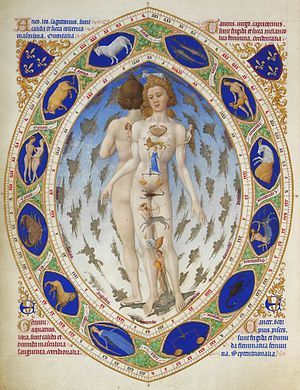
A 1410 illustration of Zodiac Man (homo signorum) showing the anciently-held link between the 12 signs of the Zodiac and the various parts of the body
Medical astrology (traditionally known as Iatromathematics) is an ancient medical system that associates various parts of the body, diseases, and drugs as under the influence of the sun, moon, and planets, along with the twelve astrological signs. Each of the astrological signs (along with the sun, moon, and planets) is associated with different parts of the human body. The underlying basis for medical astrology, astrology itself, is considered to be a pseudoscience or superstition as there is no scientific basis for its core beliefs.
Overview

This table, from an 18th-century Icelandic manuscript, links astrological dates with the preparation of medicine.
Medical astrology posits the association of each sign of the zodiac with parts of the body, and was already mentioned by Marcus Manilius (1st century AD) in his epic poem (8000 verses) Astronomica. The signs of the zodiac were believed to preside over the parts of the body, covering the body from head (Aries) to toe (Pisces), as follows:
- Aries – head, face, brain, eyes
- Taurus – throat, neck, thyroid gland, vocal tract
- Gemini – arms, lungs, shoulders, hands, nervous system, brain
- Cancer – chest, breasts, stomach, alimentary canal
- Leo – heart, chest, spine, spinal column, upper back
- Virgo – digestive system, intestines, spleen, nervous system
- Libra – kidneys, skin, lumbar region, buttocks
- Scorpio – reproductive system, sexual organs, bowels, excretory system
- Sagittarius – hips, thighs, liver, sciatic nerve
- Capricorn – knees, joints, skeletal system
- Aquarius – ankles, calves, circulatory system
- Pisces – feet, toes, lymphatic system, adipose tissue
The planets are also associated with certain portions and functions within the body:
- Sun – heart, spine, and general vitality
- Moon – stomach, digestive system, female organs, lymphatic system
- Mercury – brain, central nervous system, thyroid gland, five senses, hands
- Venus – throat, kidneys, thymus gland, sense of touch, ovaries
- Mars – muscles, head, adrenal glands, senses of smell and taste
- Jupiter – liver, thighs, feet, growth, pituitary gland
- Saturn – skin, hair, teeth, bones, the body’s defenses, spleen
- Uranus – parathyroid gland, neural activity, aura
- Neptune – pineal gland, psychic healing
- Pluto – pancreas, metabolism, elimination
After examining an individual’s natal chart, a medical astrologer may give advice to the client about the areas of the body in which they are most likely to experience trouble. For instance, an individual with the Sun, Moon, Ascendant, or many planets in the sign of Aries is presumed to have more headaches than other people because of the association of Aries with the head. A person with Taurus strong in the natal chart is predicted to have many sore throats and problems with the voice because of the Taurean association with that particular part of the body.
Publications
- Cornell, H.L., M.D., The Encyclopaedia of Medical Astrology (1933), Astrology Classics [Abington, MD, 2010.]
- Culpepper, Nicholas, Astrological Judgement of Diseases from the Decumbiture of the Sick (1655) ISBN 1-5381-0113-0
- Ficino, Marsilio, Three Books on Life (1489) [De vita libri tre] translated by Carol V. Kaske and John R. Clark, Center for Medieval and Early Renaissance Studies, State University of New York at Binghamton and The Reaissance Society of America (1989.) ISBN 0-86698-041-5
- Gailing, Stephanie, Planetary Apothecary, ISBN 978-1-58091-191-7
- Heindel, Max & Heindel, Augusta Foss, The Message of the Stars (Part II: Medical Astrology), ISBN 0-911274-18-9
- Heindel, Max & Heindel, Augusta Foss, Astro-Diagnosis – A Guide to Healing, ISBN 0-911274-06-5
- Nauman, Eileen, Medical Astrology, ISBN 0-9634662-4
- Ridder-Patrick, Jane, A Handbook of Medical Astrology, ISBN 978-0-9551989-0-8
- Saunders, Richard, The Astrological Judgment and Practice of Physick (1677) ISBN 1-161-41322-7
- Lilly, William, Christian Astrology (1647)
See also
References
- “Activities With Astrology”. Astronomical society of the Pacific.
- “Objections to Astrology: A Statement by 186 Leading Scientists”. The Humanist, September/October 1975.
- Robert Hand. “The History of Astrology — Another View”. Retrieved 2007-06-19.
- Eysenck, H.J., Nias, D.K.B., Astrology: Science or Superstition? (Penguin Books, 1982)
- Richard Dawkins. “The Real Romance in the Stars“. The Independent, December 1995.
- “British Physicist Debunks Astrology in Indian Lecture”. Associated Press.
- “Astronomical Pseudo-Science: A Skeptic’s Resource List”. Astronomical Society of the Pacific.
- Paul R. Thagard, ‘Why Astrology is a Pseudoscience‘, PSA, vol 1. University of Chicago Press, 1978.
- “Rulerships and Qualities: Anatomy and Physiology Correlated to the Zodiac”. The Rosicrucian Fellowship. Retrieved 2011-06-19.
|
|
||
|
|
||

